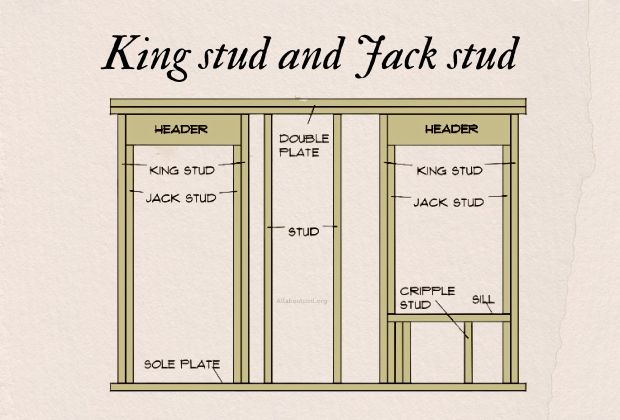What is a Stud in Construction?
A Stud in construction refers to a vertical framing member used to provide structural support in walls, particularly wood framing. These studs help in distributing the loads and ensuring the stability and integrity of the overall structure.
There are many studs in construction but the following are two main types of studs.
- King Stud
- Jack Stud
What is a King Stud?
King stud serves as a primary vertical support member in wall framing, that extends continuously from the bottom plate to the top plate of a wall or around openings such as doors and windows.
The king stud bears the load of structural components like headers and provides essential stability to the overall structure.
King Stud Uses
- Used as primary vertical support in wall framing.
- King stud provides structural stability to the entire wall assembly.
- They support structural elements such as headers, beams, and load-bearing walls.
Advantages of King Stud
- King stud offers continuous vertical support along the length of the wall.
- Provides robust support for heavy loads and structural components.
- King stud ensures consistent structural integrity throughout the wall assembly.
- Essential for framing around door and window openings.
Disadvantages of King Stud
- King stud requires larger and stronger materials than jack studs, potentially increasing construction costs.
- Limited flexibility in design due to continuous placement along the wall.
Also Read: Corner Window Design Ideas for House – Pros, Con’s & Uses
What is a Jack Stud?
A jack stud is a shorter vertical member positioned adjacent to an opening, sandwiched between the king stud and the header. King stud and Jack stud work together to support the weight of headers and distribute loads effectively.
They play a crucial role in maintaining the structural integrity of the wall assembly while accommodating door and window openings.
Jack Stud Uses
- Provides supplemental support around door and window openings.
- Supports headers and distributes loads to the king stud and surrounding wall structure.
- Jack stud allows the installation of doors, windows, and other openings within the wall assembly.
Advantages of Jack Stud
- Jack stud offers flexibility in accommodating various door and window sizes.
- Allows for efficient load distribution, reducing the strain on the overall wall structure.
- Can be adjusted to fit specific opening dimensions, enhancing customization options.
- Jack stud contributes to the efficient use of materials by providing support only where necessary.
Disadvantages of Jack Stud
- Relies on the strength of the king stud for structural support, potentially limiting load-bearing capacity.
- Jack studs may require additional reinforcement for larger openings or heavy structural components.
- Introduces interruptions in the continuous wall framing, which could impact overall structural integrity if not properly installed.
Also Read: Floor Joist – Types | Span Chart | Standard Sizes | Spacings | Advantages
King Stud and Jack Stud Differences
King studs and jack studs are two important members of the wall assembly, they play crucial roles in stability and load bearing of structure.
Following are the differences between King Stud and Jack Stud:
| King Stud | Jack Stud |
|---|---|
| King studs are full-length vertical support member | Jack stud are shorter vertical members positioned adjacent to openings |
| King studs primary vertical support for the entire wall | Jack studs are supplementary support for headers and distributing loads. |
| These are placed at ends of walls and around openings | These are placed at adjacent to openings |
| King studs are larger and stronger | Jack studs are smaller but robust |
| King studs bear majority of the vertical load | Assists in distributing load to King stud |
| Located at ends and openings of wall assembly | Adjacent to openings within wall assembly |
| Runs continuously along the wall | Interrupted by openings |

